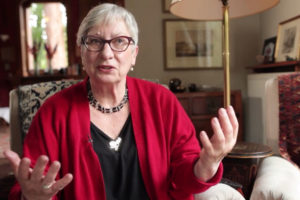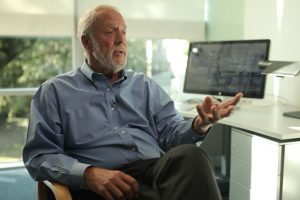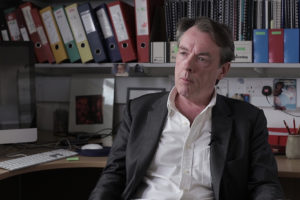Dyslexia
Developmental psychologist Uta Frith on the detection of dyslexia in children, difficulties with sound recogni...
The video is a part of the project British Scientists produced in collaboration between Serious Science and the British Council.
September 9th, 1971. An English musician releases an album in the United States of America. The musician is John Lennon and the first track of this album became then an iconic music, a song full of poetry, of melody: «Imagine». Of course, we all enjoy the music but did we really realize the text? «Imagine there is no heaven, only sky above us, it’s easy if you try». My point is that it’s not easy at all; no, it’s not easy. My point is that it is not possible to imagine a world without other worlds. Every civilization throughout the centuries, throughout the millennia, has imagined another world, a heaven. Mount Meru for the Hindus is the paradise of Brahma, the Greeks and the Romans had the Golden Age, the kingdom of Saturn and then, of course, comes the biblical faith and the Prophet Muhammad was carried up to heaven to Al Jannah, the garden of paradise.
It is interesting to explain the career of this fascinating term «paradise». This term has an amazing career, because it started around the second millennium BC. We know from a very scarce material that this word «pairidaēza» was on the lips of a very ancient tribe living in Iran — the Medes. And we know that around the 8th century «pairidaēza» was used by Persian in the Persian Empire to indicate these beautiful royal parks where the princes of the Persian Empire would enjoy hunting. And then the word had a kind of adventure because the very first turning point was when the Greek historian Xenophon in the 4th century BC translated this word «pairidaēza» which in ancient Persian meant «a secluded place», «a place surrounded by a clay wall», he translated that when he talked about and wrote about Persia that he knew very well with the Greek «parádeisos». Then in the 3rd century BC the famous seventy scholars who translated the Hebrew Bible into Greek when they read in Hebrew in the book of Genesis the references to «gan Eden» they translated «gan Eden» into «parádeisos». So they use the Greek word coming from the Persian terminology.
What is fascinating is that later on around the 2nd century BC in Hebrew circles the word «parádeisos», the notion, became to be referred also to another world, the heavenly paradise. Hence the two things overlapped so much so that in the first century as we all know Christ was dying on the cross and the Good Thief made the last theft of his life, the best, he obtained a right to go to paradise: Christ said «Today you will be with me in paradise» and definitely he didn’t mean the Garden of Eden but he meant the heavenly paradise. So the confusion, the overlapping goes back to the early times and this is why, I think, it’s very important to explain that my research is on the earthly Eden which, to cut a very long story short, became to be clearly defined only since Augustine around 400.
St Augustine was the authority who very clearly distinguished the Garden of Eden, the natural and earthly condition of Adam and Eve, from heaven, from the resurrected bodies the blessed will have at the end of time. So as we know the medieval doctrine was very much influenced by Augustin. The idea was that humankind would progress from the Garden of Eden from which they were expelled through history up to the heavenly paradise. My interest is in this very Western Latin notion that developed from Augustin’s reading of Genesis. For Augustin it was very important to defend the literal authority of Scripture, it was very important to defend the goodness of material life against heretics and gnostic, neoplatonic tendencies to see the lower world, the materiality as impure. For Augustin it was very important to show that the material creation was created by God, was good, the body is created by God, we are meant to be embodied. This is very important for me because many modern not only popular thinkers but even scholars forget what was the intellectual context of Augustin. Other fathers of the church did not think in these terms, they thought that we had the body and sexuality because of sin. What Augustin notion implied was that if Adam and Eve had a body they had to have a place, a material space and this material space was the Garden of Eden.
And upon this combination of time and space is based the whole mapmaking from the Middle Ages. And my own interest was to show that Medieval cartography was not simply a very naïve, unscientific, bizarre, superstitious practice; it was scientific, it was science in its own term. I think the 19th century’s and also 20th century’s scholarly approach to this topic showed a bit of condescendant smirk, a sort of superiority: we are modern, we know how the world looks like, we know that these people were wrong and we know that there was a progress, that we made discoveries, our technology is better, we mapped the world much better than they did. They even put monsters, marvels, religious stuff; no-no, this is not science. I hope to have shown that this is not true and I think it’s important to learn a lesson of humility: our culture, our science, our technology is just different, it’s not necessarily better than theirs.
So my point was to look at the medieval cartography, to understand the mapping of Paradise which was not just the mapping of a fantasy place but it was an inclusion of the temporal dimension. Medieval maps are chronicle, historical chronicle showing us the events where they took place and there is a vision of mankind’s history going from the far east from the Garden of Eden moving westwards, centering in Jerusalem where the peak event of human history took place, the Passion of Christ, and then finally from the early Eastern Kingdoms moved to the Mediterranean basin of the Roman Empire and this was the end, the end in spatial terms in the end also in temporal dimension. The end was near. This is to say that the mapping of the garden region was not just an isolated superstitious practice: it was part of a much wider vision of human salvation history, a history that started in the Garden of Eden which was seen as an intriguing notion of a heaven located somewhere on Earth. We can see now, we can appreciate it as this medieval notion of a Garden of Eden on Earth was not just a fantasy, bizarre, superstitious, ultra devotional approach, unscientific idea to the representation of the world: the Garden of Eden was part of a wider vision of mankind’s salvation history, it is it was where everything began.

I find very interesting to appreciate one aspect of the medieval «weltanschauung» that they conceived of a section of creation still untouched by the corruption of human sin. There was somewhere in the Orient some portion of the Earth that was still coming directly of the hands of God, it was still a heaven on Earth; it was still before «before». Nobody knew where it was, nobody even dared to think that they could approach it in the lifetime but it was a consoling idea that there was something there. It was also a reminder of the seriousness of human fall, a human sin that made such a beautiful reality becoming unapproachable. Later on this idea will develop in different directions and it is interesting to see how Renaissance, Reformation and modern thinkers try to say the same thing in completely different terms and in completely different contexts, in a completely different way. Paradise was lost because of human sin and in the Middle Ages was distanced in the space, it was in a remote east. For modern thinkers paradise became lost in time: it was no longer there, you could go there, you could approach the real location but you wouldn’t find the Garden of Eden of Adam and Eve because it was destroyed.

Developmental psychologist Uta Frith on the detection of dyslexia in children, difficulties with sound recogni...

Behavioral geneticist Robert Plomin on twin studies, genetic influence of parents on their children, and 1% of...

Biogerontologist David Gems on the senescence, medical approach to aging and how can you research the fundamen...